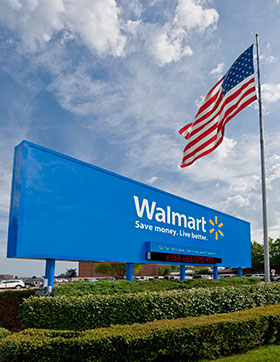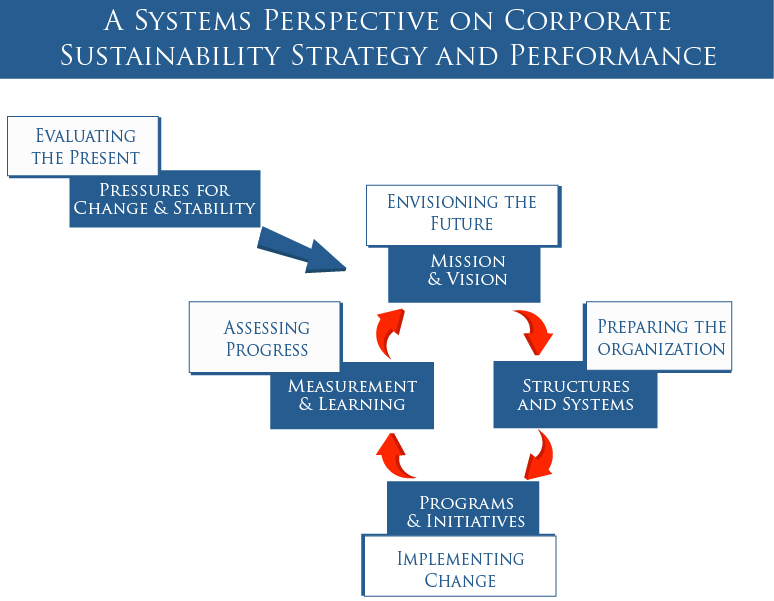Walmart Sustainability Case Project
The goal of the Walmart sustainability case project is to develop teaching cases and notes that lead students through an in-depth analysis of Walmart's efforts to develop and implement an ambitious corporate sustainability strategy.

For more information about the Walmart Sustainability Case Project, please feel free
to contact David G. Hyatt at the University of Arkansas or Andrew Spicer at the University of South Carolina.
Collaboration

To accomplish this task, professors from the Sam M. Walton College of Business, University of Arkansas, and the Moore School of Business, University of South Carolina, collaborated to write a series of cases that explores Walmart's sustainability journey from different positions and perspectives.
View/Download The Case Studies View Other Studies
Interviews
During the project, our team conducted over 30 interviews that included over 25 Walmart employees who worked on the front lines developing and implementing the company's new sustainability strategy.
Designated Purpose
These cases are not designed to provide a comprehensive examination of the full set of issues that Walmart has encountered during its ongoing sustainability journey. In choosing these cases, we have attempted to identify specific decision points pertaining to the company's sustainability efforts that can lead to engaged, thoughtful classroom discussions of the opportunities and challenges involved in designing and implementing a wide-ranging corporate sustainability strategy.
The cases are designed to be taught alone or as a series, but there are distinct advantages to teaching them as a series.
Doing so allows instructors and students to examine recurring issues and questions across positions, tasks, and time, including different levels of the organization (CEO, sustainability director, functional managers), strategic decision-making stages (vision, strategy, implementation, measurement), and periods (from vision to implementation, and back again).
Framework
To link the individual cases together as an interconnected learning experience, we have relied on the following framework:

The available cases correspond to this figure as follows:
- Mission and Vision—"Lee Scott's Founding Vision"
- Structures and Systems—"Andy Ruben and the Design of Organizational Structures and Systems (A & B)"
- Programs and Initiatives—"Peter Redmond and the Search for Sustainable Seafood"; "Bottled Water Logistics and Forecasting"; "Walmart's Sustainability Journey: Elizabeth Fretheim and the Search for Sustainable Trucking "
- Measurement and Learning—"Defining Sustainable Products (A & B)"; "Consumers and Sustainability at Walmart: A Student's Perspective"
We recommend teaching the cases pertaining to organizational mission and strategy prior to moving on to cases about particular initiatives and systemic reporting metrics. If instructors choose to teach the latter cases as stand-alone presentations, the earlier cases remain available to provide additional background information for class discussion.
Case Series Overview

The first case—"Lee Scott's Founding Vision"—takes the perspective from the apex of the organization as Walmart's CEO, Lee Scott, develops and articulates his vision of what Walmart hopes to achieve by pursuing an aggressive sustainability strategy. This case explores the pressures that led Scott to announce the company's ambitious sustainability goals: achieving zero waste, 100% renewable energy, and selling sustainable products. It also explores the choices made when defining and communicating the scope of the strategy, particularly through an in-depth analysis of his announcement of Walmart's new goals in his October 2005, "Twenty-First Century Leadership" speech.
The case "Andy Ruben and the Design of Organizational Structures and Systems" flows from the previous discussion, by moving from the development of an ambitious vision to the challenges of adopting strategic policies and processes to reach those aspirations in practice. This case puts students into the role of Andy Ruben, Walmart's first Vice-President for Sustainability , asking them to make concrete decisions about what should be done, in what order, and by what process if they were to implement an ambitious corporate sustainability strategy. In the case, Ruben confronts specific choices about how to define the responsibilities of the new sustainability office at Walmart in his efforts to lead the organization toward achieving Lee Scott's vision. In Case B, we review the basic decisions Ruben made while building the resultant sustainability office.
The next group of cases asks students to move from organization-wide decisions about mission and strategy to explore specific choices about which initiatives to pursue at the individual product and practice levels. In these cases, higher-level strategic choices operate as the context for line managers, who must make concrete decisions about how to achieve new sustainability goals in their own business operations. In "Peter Redmond and the Search for Sustainable Seafood," students examine the responses of Peter Redmond, Vice President and Divisional Merchandise Manager of Deli and Seafood, to organizational pressures to make seafood more sustainable at Walmart. In a second case, we look at bottled water. We have two versions. The longer version includes data that students can use in forecasting bottled water. (The longer case is best used for an operations class; the shorter one is appropriate if the instructor wishes to teach within the case series or as stand-alone within a sustainability course.) Both cases illustrate the clash, as well as the complementarity, between Walmart's business model and their professed sustainability goals. The case also provides students with the opportunity to explore how Walmart might become more efficient, but at the expense of overall system efficiency. We are continuing to develop an additional series of cases—on LED light bulbs and plastic bags—that will further explore the detailed challenges involved in choosing concrete initiatives aligned with the new sustainability strategy.
Outcomes
Finally, we move full circle from initial vision, strategy, and initiatives to measuring progress over time, against initial goals and aspirations. In particular, in "Defining Sustainable Products (A)," we examine Walmart's search for a systemic solution to define a sustainable product precisely. In this case, Matt Kistler, who succeeded Andy Ruben as the company sustainability leader in 2007, knows that the company is lagging behind on its espoused goal of selling sustainable products. The case asks students step into Kistler's shoes as he leads Walmart's sustainability office through a systematic review of the different models and frameworks available for measuring the sustainability of products presently in use. Eventually, the students face a decision about what Walmart should do to make systemic progress with regard to measuring and selling sustainable products. In "Defining Sustainable Products (B)," we examine the situation three years later, as Walmart assesses the progress made in achieving its goal of selling sustainable products.
Perspectives
To further encourage students to analyze initial goals in comparison with outcomes over time, we have developed a consumer-oriented case—"Consumers and Sustainability at Walmart: A Student's Perspective"—that moves beyond the perspective of internal Walmart participants to explores issues of sustainability from the point of view of a typical Walmart shopper. In this case, we examine the experience of a fictional student shopper who goes to Walmart and wants to buy sustainable products, which helps raise questions for students about what Walmart's actions mean to them as consumers, citizens as well as business professionals. The case also asks students to evaluate the progress that Walmart has made in its stores over the course of its sustainability journey, particularly in comparison to its initial aspirations and goals.
By allowing students to switch roles and perspectives throughout this case series, we hope that they ultimately come to recognize the systemic interdependencies that define and shape the opportunities and challenges of designing and leading an ambitious corporate sustainability strategy. Over time, we plan to add more cases, articles, and teaching notes to offer additional perspectives and guidance to the material already developed. Along these lines, we welcome and encourage feedback from educators about the strategies that they have used to teach these cases, as well as any other information they might care to share about other Walmart sustainability cases, articles, or commentary, to which we can link through this website.
Cases
The authors drew on 30 interviews, 25 of which were with current or former employees of Walmart, in developing the case series. They also drew on public information. In each case, the respective authors have strived to present a factual accounting. The cases and their links are presented below, categorized according to whether they have been reviewed by Walmart or not.
The first set of cases are based primarily on interviews with employees of Walmart and have been reviewed by Walmart for factual accuracy. However, this review does not constitute an endorsement of the cases or their completeness.
- Lee Scott’s Founding Vision PDF
- Andy Ruben and the Design of Organizational Structures and Systems (A)
- Andy Ruben and the Design of Organizational Structures and Systems (B)
- Peter Redmond and the Search for Sustainable Seafood (mini-case)
- Bottled Water Logistics and Forecasting
- Defining Sustainable Products (A)
- Defining Sustainable Products (B)
- Walmart’s Sustainability Journey: Elizabeth Fretheim and the Search for Sustainable
Trucking
The second set of cases are based primarily on public information and have not been reviewed by Walmart for factual accuracy.
Teaching Resource
Based on an extensive analysis of the case studies and subsequent events, the case study authors wrote a journal article that can be used as a resource for faculty using the cases in their classrooms (as well as managers).
Spicer, Andrew, and David Graham Hyatt. "Walmart’s Emergent Low-Cost Sustainable Product Strategy." California Management Review 59, no. 2 (2017): 116-41.
In the paper we describe how Walmart, in its search for sustainability, sought cross-sectoral cooperation through the Consortium to produce a level playing field better able to define the emergent rules of market competition on sustainable products. This turned out to be very difficult work and over time the company strengthened is supplier-facing sustainability strategy, placing less emphasis on consumer-facing initiatives.
Accordingly, we analyze Walmart’s lessons learned from an “emergent strategy” perspective that suggests that corporations often update and adapt their original plans as managers learn from experience over time. This is a stark contrast to narratives that suggest the consumer-facing initiatives are just greenwashing.
The article uses concepts including the role of institutional intermediaries, transaction costs, and experiential learning in shaping firms’ capabilities to translate ambitious sustainability goals into operable, mass-market initiatives.”
Faculty Contacts
- University of Arkansas: David G. Hyatt
- University of South Carolina: Andrew Spicer
Other Studies
We are aware of other cases that illustrate Walmart’s sustainability strategy:
- Plambeck, E. L., & Denend, L. 2007. Walmart’s sustainability strategy (A), Case: OIT-71A. Stanford, CA: Stanford University.
- Plambeck, E. L., & Denend, L. 2010. Walmart’s sustainability strategy (B): 2010 update, Case: OIT-71B. Stanford, CA: Stanford University.
- Plambeck, E. L., & Denend, L. 2010. Walmart’s sustainability strategy (c): Inventory management in the seafood supply chain, Case: OIT-71C. Stanford, CA: Stanford University.
- Gupta, V., & Chakraborty. 2009. Wal-Mart's sustainability initiative: The packaging scorecard, Reference no. 709-038-8. Hyderabad: ICMR Center for Management Research, Distributed by ECCH.
- Robb, D., Hopwood, B., Wang, L., & Cheng, J. 2009. Wal-Mart China: Sustainable operations strategy, Case: 9B08D009. London, Ontario: Tsinghua School of Economics and Management and Ivey Management Services.
- Comas, M., & Sagebien, J. 2010. Wal-Mart Puerto Rico: Promoting development through a public-private partnership, Case: 9B10M024. London, Ontario: Ivey Management Services.
- Smith, N. C., & Crawford, R. 2011. Wal-Mart's sustainable product index Case 07/2011-5751. Bedfordshire, UK: INSEAD, Distributed by ECCH.
- Smith, N. C., & Crawford, R. 2011. Walmart: Love, Earth (A) & (B), Case 09/2011-5830. Bedfordshire, UK: INSEAD, Distributed by ECCH.
- Rosegrant, S., & Leonard, H. B. 2007. Wal-Mart's response to hurricane Katrina, Striving for public-private partnership, Kennedy School of Government Case Program C16-07-1876.0: Harvard Business Publishing.